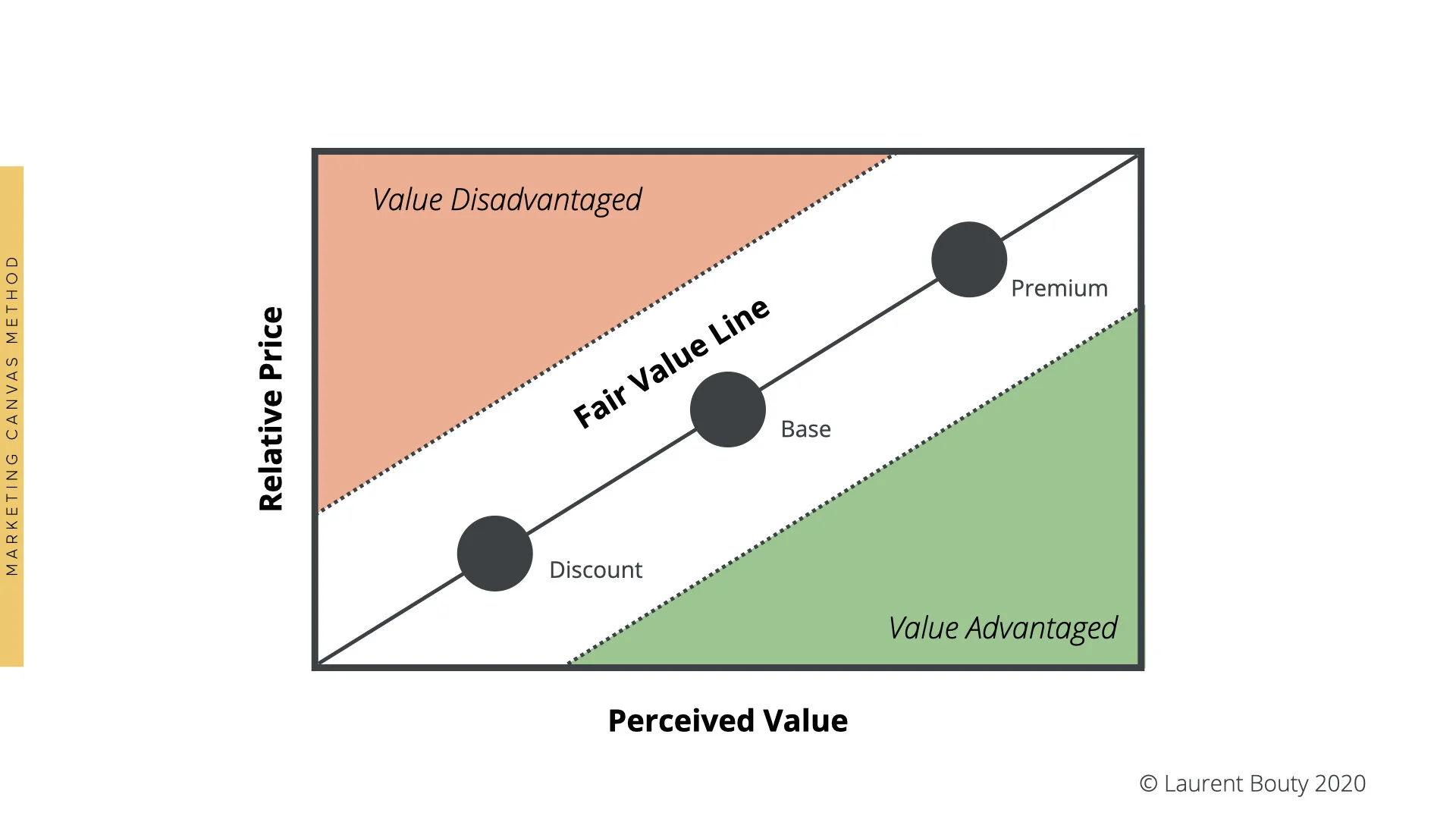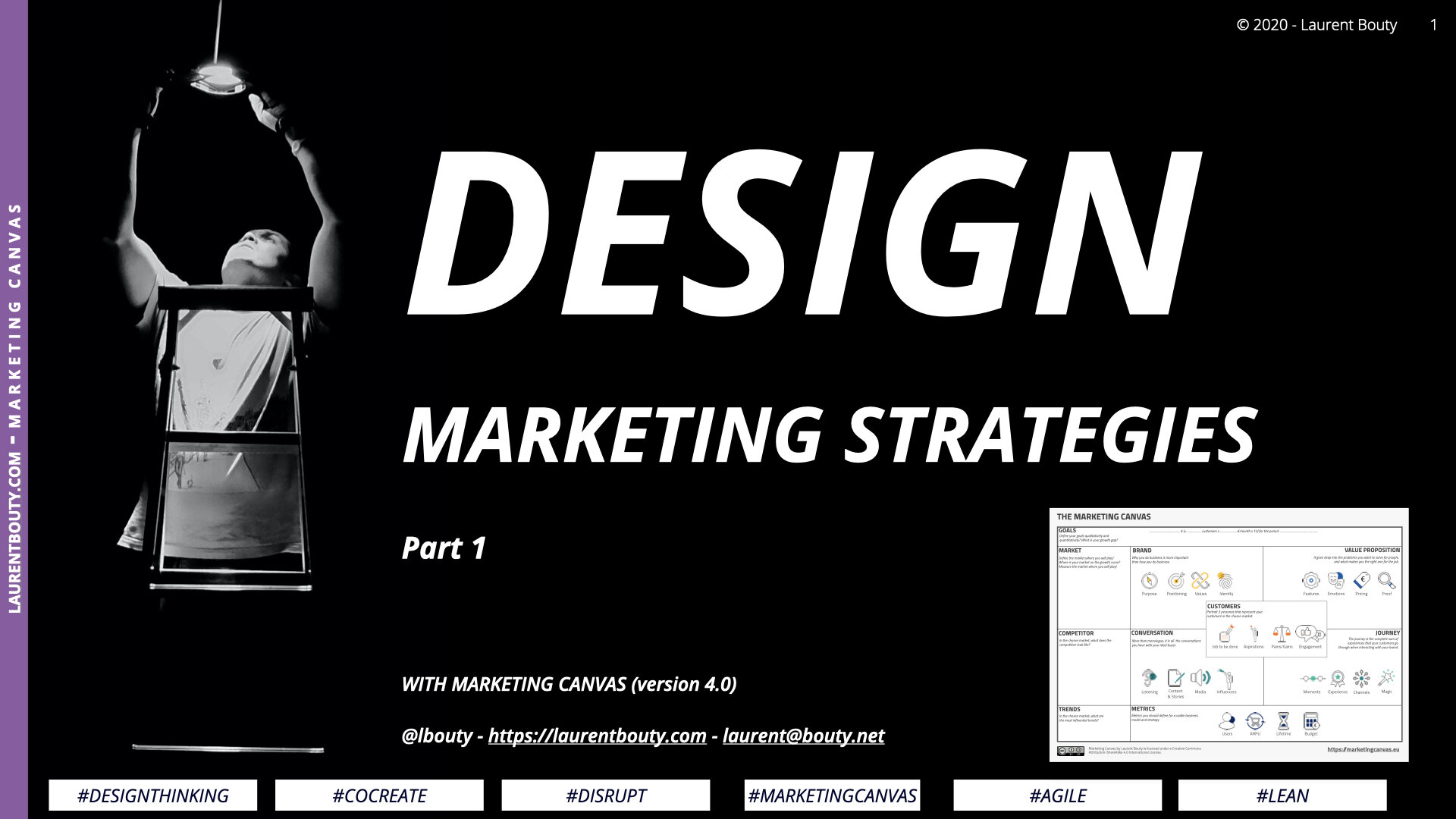Last update: 24/5/2023
In a nutshell
PRICING is probably of the most technical aspect of Marketing. Good pricing strategies are value-based (transformational), connected with the market demands and the brand (purpose, positioning). Not considering a value-based approach will be ….
In the Marketing Canvas
The Marketing Canvas is a comprehensive tool designed to aid entrepreneurs, non-marketers, and those keen on refining their marketing knowledge in constructing a solid marketing strategy. Comprising six primary categories, each divided into four dimensions, it offers a total of 24 dimensions that together shape your Marketing Strategy. A critical piece of this puzzle is the dimension of PRICING, which is part of the VALUE PROPOSITION category.
How do you use it?
PRICING is a dimension that demands comprehensive analysis due to its intricate nature and significant impact on your overarching strategy. In the Marketing Canvas Method, PRICING is considered not merely in the context of competing with pre-established market prices for similar products or services but as a strategy to create or preserve value, thereby propelling you upwards on the economic value curve.
One key element of pricing is the 'Perceived Price.' In any market, the selling price is determined using a standard unit of measurement. Understanding this uniformity in pricing units is fundamental to grasping the pricing structure.
For instance, in a supermarket, shampoos and soaps are priced per volume (ml in Europe), while coffee is sold by weight. In the service industry, consulting services are typically charged by the hour or day.
After identifying your market's reference pricing unit, you can calculate the perceived price for your offering and your competitors. This calculation is based on the formula:
24/(E-C)*(M7-C)-12
Here:
E is the maximum unit price in the market,
C is the cheapest unit price,
M7 is your unit price.
This equation helps identify your position on the value curve, providing insight into whether your pricing strategy accelerates or impedes your business.
For example, if you're selling artisanal coffee beans priced at $15 per pound (M7), and in the market, the highest-priced coffee is $20 per pound (E) and the cheapest is $10 per pound (C), your position on the value curve can be determined using the formula. This insight can guide you on whether you need to adjust your pricing to better align with the perceived value and market conditions.
PRICING is intrinsically linked to the perceived value of your product or service. If customers perceive your offering as a commodity, they'll likely choose the cheapest option. But, if they discern your unique value proposition compared to competitors, they may be inclined to pay the same or slightly more.
Consider Starbucks: customers are willing to pay more for their coffee because they perceive it to offer a unique experience. On the other hand, a luxury fashion brand can charge high prices because they offer a transformational experience, making the price a secondary consideration for their target customers.
An effective PRICING strategy should:
Be Value-Based: Align with your position on the economic value curve.
Consider Market Conditions: Understand competitor pricing and customer price sensitivity.
Enhance Your Brand’s Purpose and Positioning: Your pricing should reflect your brand identity. For instance, if you're a game-changer, your price should also disrupt the market norms.
Strengthen Your Value Proposition: Emphasize the unique aspects of your product or service.
Failure to adhere to these guidelines could result in a PRICING strategy that acts as a brake, slowing your progress rather than accelerating it.
To assess your pricing strategy, score it on a scale of -12 to +12. A -12 represents a low price but possibly a low perceived value, while +12 signifies a high price with potentially high perceived value.
This scale allows for a nuanced understanding of your pricing position relative to the market's price range and the perceived value of your product or or service. For example, if your artisanal coffee is priced higher than the average market price, but customers appreciate its unique sourcing and quality, resulting in a high perceived value, you might score a +8 or even higher on this scale.
Value Map that helps you understand your current pricing situation
Guidelines
A few guidelines and tips to remember when applying the PRICING dimension of the Marketing Canvas include:
Understand your market: Before setting your pricing, it's crucial to have a thorough understanding of your market, including the average price range, the competition, and your customers' price sensitivity.
Know your value: Understand the unique value your product or service provides to customers. This value is a key factor in how much customers are willing to pay.
Be flexible: Markets and customer preferences can change. Regularly revisit your pricing strategy to ensure it stays aligned with market conditions and your value proposition.
Test your pricing: Don't be afraid to experiment with different pricing strategies to see what works best for your business. This could involve A/B testing different price points, offering discounts or premium versions, or bundling products or services.
Communicate value: Ensure your marketing and sales efforts effectively communicate the unique value your product or service offers. This can help justify your price and influence the perceived value.
Remember, a successful PRICING strategy not only covers the costs and provides a profit margin but also accurately reflects the perceived value of your offering. With the right approach, your pricing can act as an accelerator, propelling your business forward rather than hindering its progress.
Question
Is the PRICING of your Value Proposition helping you achieve your goals?
To assess this, rate your agreement with the following statements on a scale from -3 (completely disagree) to +3 (completely agree):
Your value proposition is creating more value than the cost of the next best alternative for your customers.
If you score positively (+1 to +3), your product or service likely provides significant benefits that differentiate it from competitors. Customers perceive the additional value, justifying a potential premium price.
A negative score (-1 to -3) might indicate that your offering does not provide enough distinct value compared to alternatives, impacting your pricing power. This could warrant a review of your value proposition or a potential adjustment to your pricing.
Your pricing strategy is based on customer Willingness To Pay (WTP) for solving his/her problem.
A positive score on this statement suggests your pricing is well-aligned with the value perceived by your customers. Your pricing matches their WTP, optimizing both customer satisfaction and profitability.
A negative score could mean that your pricing is out of sync with customer perception. You might be charging too much for the value provided, or conversely, undervaluing your offering, both of which can lead to suboptimal results.
Your pricing strategy takes into account all costs associated with your value proposition.
Positive scores indicate that your pricing strategy effectively covers all costs, ensuring profitability. Your pricing provides a sufficient margin above costs, which is critical for business sustainability.
A negative score, however, may suggest your pricing does not fully cover the costs. You might be underestimating indirect costs, or your price might simply be too low. This could lead to losses in the long run, making this a critical area to address.
Your pricing strategy is aligned with your brand positioning and your goals for the category.
Positive scores here indicate your pricing reinforces your brand image and contributes to achieving your business goals. For instance, premium pricing for a luxury brand reinforces its high-end positioning, while competitive pricing for a value brand supports a market penetration strategy.
Negative scores suggest a misalignment. Your pricing may contradict your brand image (e.g., low prices for a premium brand) or hinder your business objectives (e.g., high prices inhibiting market penetration). Correcting such discrepancies can enhance both your brand's consistency and business performance.
Remember, these ratings should serve as a starting point for reflection and discussion. Analyzing these scores will provide valuable insights, helping you to refine your pricing strategy for greater success.
Sources
Market and Economic Value, Laurent Bouty, https://laurentbouty.com/blog/2019/marketing-canvas-market-and-economic-value
Neil Patel - 5 Psychological Studies on Pricing That You Absolutely MUST Read, https://neilpatel.com/blog/5-psychological-studies/
The Ultimate Guide to Pricing Strategies, https://blog.hubspot.com/sales/pricing-strategy
Replyco, 23 Pricing Strategies Any eCommerce Seller Can Use to Increase Sales, https://replyco.com/brainery/23-pricing-strategies-for-ecommerce-sellers/
More on the Marketing Canvas
Marketing Canvas by Laurent Bouty






































